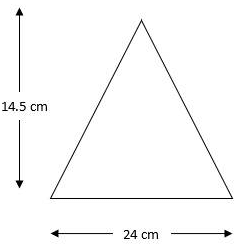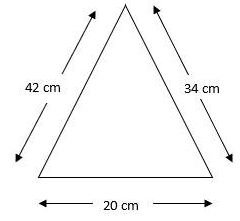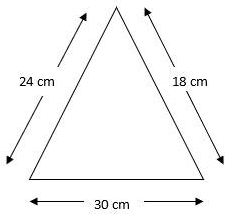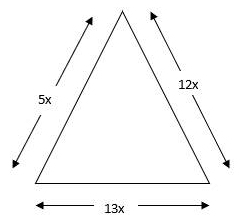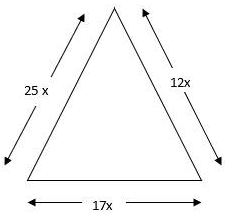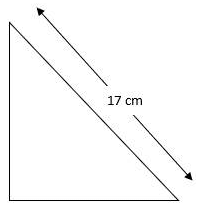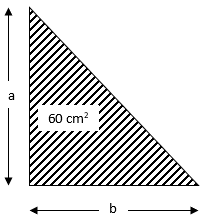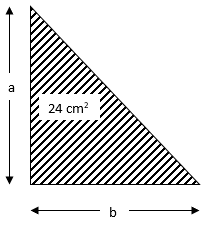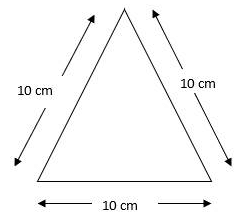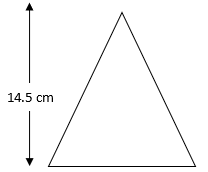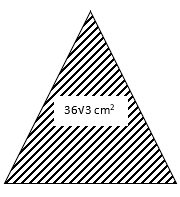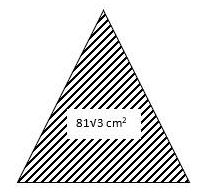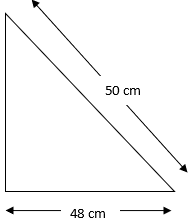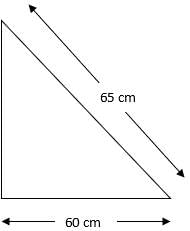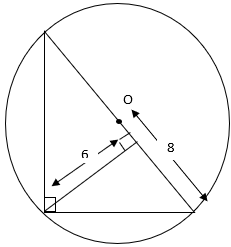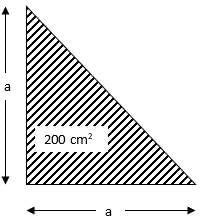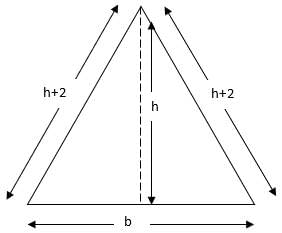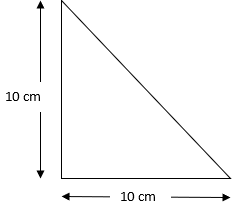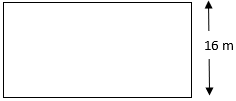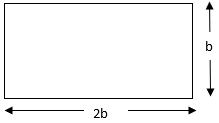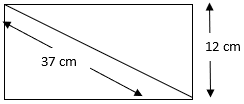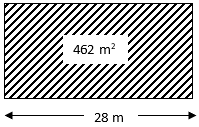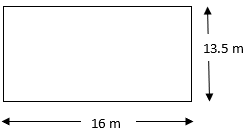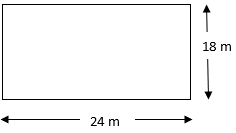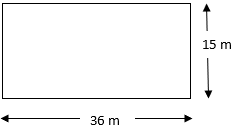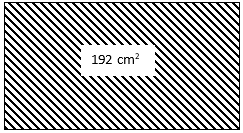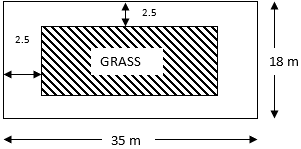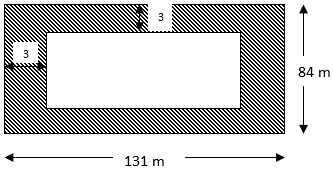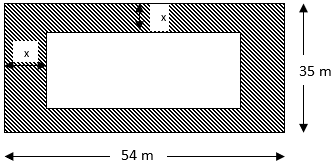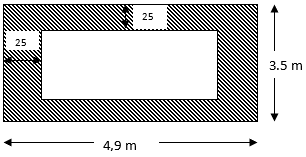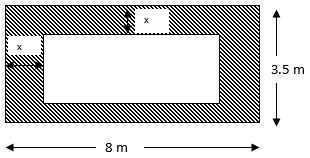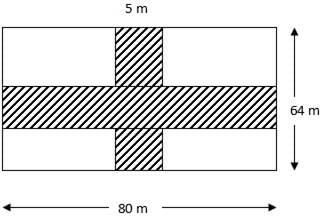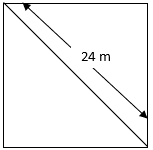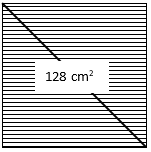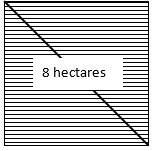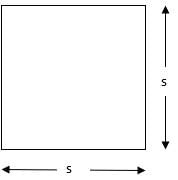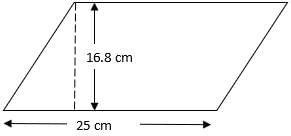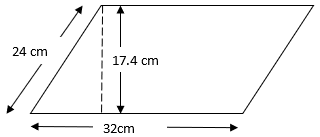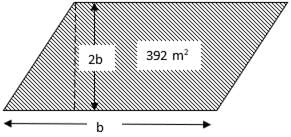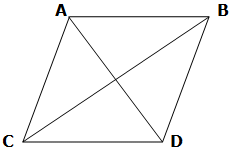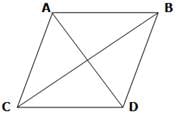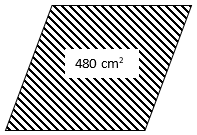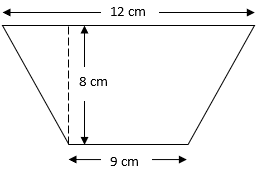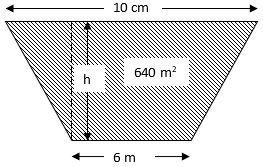RS Aggarwal Solutions: Perimeter and Area of Plane Figures- 1 - Class 10 PDF Download
Exercise: 17a
Q.1. Find the area of the triangle whose base measures 24 cm and the corresponding height measures 14.5 cm.
Given: Base = 24 cm
Height = 14.5 cm
We know that,
Area of a triangle = 1/2 × Base × Height
= 1/2 × 24 cm × 14.5 cm
= 174 cm2
Q.2. Find the area of the triangle whose sides are 42 cm, 34 cm and 20 cm. Also, find the height corresponding to the longest side.
Given: Side 1 = a (let) = 42 cm
Side 2 = b (let) = 34 cm
Side 3 = c (let) = 20 cm
We know that,
Area of a scalene triangle = √(s(s-a) (s-b) (s-c))
Where,
⇒ s = 48 cm
Now,
Area of a scalene triangle = √(48cm × (48-42)cm × (48-34)cm × (48-20)cm)
= √(48cm × 6cm × 14cm × 28cm)
= √112896 cm2
= 336 cm2
Clearly,
Length of longest side = 42 cm
Now,
We know that,
Area of a triangle = 1/2 × Base × Height
⇒ 336 cm2 = 1/2 × 42 cm × Height
⇒ 336 cm2 = 21 cm × Height
⇒ Height = 16 cm
Q.3. Find the area of the triangle whose sides are 18cm, 24cm and 30 cm. Also, find the height corresponding to the smallest side.
Given: Side 1 = a (let) = 18 cm
Side 2 = b (let) = 24 cm
Side 3 = c (let) = 30 cm
We know that,
Area of a scalene triangle = √(s(s-a)(s-b)(s-c))
Where,
⇒ s = 72/2 cm
⇒ s = 36 cm
Now,
Area of a scalene triangle = √(36cm × (36-18)cm × (36-24)cm × (36-30)cm)
= √(36cm × 18cm × 12cm × 6cm)
= √46656 cm2
= 216 cm2
Clearly,
Length of smallest side = 18 cm
Now,
We know that,
Area of a triangle = 1/2 × Base × Height
⇒ 216 cm2= 1/2 × 18 cm × Height
⇒ 216 cm2= 9 cm × Height
⇒ Height = 24 cm
Q.4. The sides of a triangle are in the ratio 5 : 12 : 13, and its perimeter is 150 cm. Find the area of the triangle.
Given: Ratio of Sides = 5 : 12 : 13
Perimeter = 150 cm
Let the sides be,
a = 5x cm
b = 12x cm
c = 13x cm
We know that,
Perimeter of a triangle = a + b + c
⇒ 150 cm = 5x cm + 12x cm + 13x cm
⇒ 150 cm = 30x cm
⇒ x = 5
Therefore,
a = 5x cm = 5 × 5 cm = 25 cm
b = 12x cm = 12 × 5 cm = 60 cm
c = 13x cm = 13 × 5 cm = 65 cm
Now,
We know that,
Area of a scalene triangle = √(s(s-a)(s-b)(s-c))
⇒ s = 75cm
Now,
Area of a scalene triangle = √(75cm × (75-25)cm × (75-60)cm × (75-65)cm)
= √(75cm × 50cm × 15cm × 10cm)
= √562500 cm2
= 750 cm2
Q.5. The perimeter of a triangle fields is 540 m, and its sides are in the ratio 25 : 17 : 12. Find the area of the fields. Also, find the cost of ploughing the field at Rs 40 per 100 m2.
Given: Ratio of Sides = 25 : 17 : 12
Perimeter = 540 m
Let the sides be,
a = 25x m
b = 17x m
c = 12x m
We know that,
Perimeter of a triangle = a + b + c
⇒ 540 m = 25x m + 17x m + 12x m
⇒ 540 m = 54x m
⇒ x = 10
Therefore,
a = 25x m = 25 × 10 m = 250 m
b = 17x m = 17 × 10 m = 170 m
c = 12x m = 12 × 10 m = 120 m
Now,
We know that,
Area of a scalene triangle = √(s(s-a)(s-b)(s-c))
⇒ s= 540/2 m
⇒ s = 270 m
Now,
Area of a scalene triangle = √(270m × (270-250)m × (270-170)m × (270-120)m) = √(270m × 20m × 10m × 150cm)
= √81000000 m2
= 9000 m2
Now,
The cost of ploughing 100 m2 = Rs 40
Therefore, The cost of ploughing 1 m2 = Rs 40/100
Therefore, The cost of ploughing 9000 m2 = Rs (40/100) x 9000
= Rs 3600
Q.6. The perimeter of a right triangle is 40 cm and its hypotenuse measures 17 cm. Find the area of the triangle.
Given: Perimeter = 40 cm
Hypotenuse = 17 cm
The diagram is given as:
Let the sides be a, b and c(hypotenuse).
Therefore, a + b + c = 40 cm
⇒ a + b + 17 = 40 cm
⇒ a + b = 40 - 17 cm
⇒ a + b = 23 cm
⇒ a = (23-b) cm
Now we know that,
Base2 + Perpendicular2 = Hypotenuse2
⇒ a2 + b2 = c2
⇒ (23-b)2 + b2 = 172
⇒ 232 + b2-46b + b2 = 289
⇒ 529 + b2-46b + b2 = 289
⇒ 2b2-46b + 240 = 0
⇒ b2-23b + 120 = 0
⇒ b2-8b-15b + 120 = 0
⇒ b(b-8)-15(b-8) = 0
⇒ (b-8)(b-15) = 0
This gives us two equations,
i. b-8 = 0
⇒ b = 8
ii. b-15 = 0
⇒ b = 15
Let b = 8 cm
⇒ a = (23-b) cm
⇒ a = (23-8) cm
⇒ a = 15 cm
Now,
Area of triangle = 1/2 × base × height
= 1/2 × 8 × 15
= 60 cm2
Q.7. The difference between the sides at right angles in a right-angled triangle is 7 cm. The area of the triangle is 60 cm2. Finds its perimeter.
Let the sides at right angles be a and b
And, the third side be c.
Given: a-b = 7 cm
Area of triangle = 60 cm2
Now, since a-b = 7
⇒ a = b + 7
Now we know that,
Area of triangle = 1/2 × base × height
⇒ 60 = 1/2 × b × (b + 7)
⇒ 60 × 2 = b2 + 7b
⇒ b2 + 7b = 120
⇒ b2 + 7b – 120 = 0
⇒ b2 + 15b - 8b – 120 = 0
⇒ b(b + 15) - 8(b + 15) = 0
⇒ (b + 15)(b-8) = 0
This gives us two equations,
i. b – 8 = 0
⇒ b = 8
ii. b + 15 = 0
⇒ b = -15
Since, the side of the triangle cannot be negative
Therefore, b = 8 cm
⇒ a = (b + 7) cm
⇒ a = (8 + 7) cm
⇒ a = 15 cm
Now we know that,
Base2 + Perpendicular2 = Hypotenuse2
⇒ a2 + b2 = c2
⇒ 152 + 82 = c2
⇒ c2 = 225 + 64
⇒ c2 = 289
⇒ c = 17
Now,
Perimeter of triangle = a + b + c
⇒ Perimeter of triangle = 15 + 8 + 17
⇒ Perimeter of triangle = 40 cm
Q.8. The lengths of the two sides of a right triangle containing the right angle differ by 2 cm. If the area of the triangles 24 cm2, find the perimeter of the triangle.
Let the sides at right angles be a and b
And, the third side be c.
Given: a-b = 2 cm
Area of triangle = 24 cm2
Now, since a-b = 2
⇒ a = b + 2
Now we know that,
Area of triangle = 1/2 × base × height
⇒ 24 = 1/2 × b × (b + 2)
⇒ 24 × 2 = b2 + 2b
⇒ b2 + 2b = 48
⇒ b2 + 2b-48 = 0
⇒ b2 + 8b-6b-48 = 0
⇒ b(b + 8)-6(b + 8) = 0
⇒ (b + 8)(b-6) = 0
This gives us two equations,
i. b + 8 = 0
⇒ b = -8
ii. b-6 = 0
⇒ b = 6
Since, the side of the triangle cannot be negative
Therefore, b = 6 cm
⇒ a = (b + 2) cm
⇒ a = (6 + 2) cm
⇒ a = 8 cm
Now we know that,
Base2 + Perpendicular2 = Hypotenuse2
⇒ a2 + b2 = c2
⇒ 82 + 62 = c2
⇒ c2 = 64 + 36
⇒ c2 = 100
⇒ c = 10
Now,
Perimeter of triangle = a + b + c
⇒ Perimeter of triangle = 8 + 6 + 10
⇒ Perimeter of triangle = 24 cm
Q.9. Each side of an equilateral triangle is 10 cm. Find (i) the area of the triangle and (ii) the height of the triangle.
Given: Side of an equilateral triangle = 10 cm
(i) Area of equilateral triangle =
= 25 x 1.732
= 43.3 cm2
(ii) Height of equilateral triangle =
= 5√3
= 5 x 1.732
= 8.66 cm2
Q.10. The height of an equilateral triangle is 6 cm. Find its area. [Take √3 = 1.73.].
Given: Height of an equilateral triangle = 6 cm
Let sides of equilateral triangle be a cm
We know that,
Height of equilateral triangle =
⇒ 6 × 2 = √3 × a
⇒ 12 = a√3
⇒ a = 4 × 1.73
= 6.92 cm2
Now,
Area of equilateral triangle =
= 11.98√3 cm2
= 20.76 cm2
Q.11. If the area of an equilateral triangle is 36√3 cm2, find its perimeter.
Given: Area of an equilateral triangle = 36√3 cm2
We know that,
Area of equilateral triangle =
⇒ side2 = 36 × 4
⇒ side = 12 cm
Now,
Perimeter of equilateral triangle = 3 × side
= 3 × 12 cm
= 36 cm
Q.12. If the area of an equilateral triangle is 81√3 cm2, find its height.
Given: Area of an equilateral triangle = 81√3 cm2
We know that,
Area of equilateral triangle =
⇒ side2 = 81 × 4
⇒ side = 18 cm
Now,
Height of equilateral triangle =
= 9√3 cm
Q.13. The base of a right-angled triangle measures 48 cm and its hypotenuse measures 50 cm. Find the area of the triangle.
Given: Base = 48 cm
Hypotenuse = 50 cm
We know that,
Base2 + Perpendicular2 = Hypotenuse2
⇒ 482 + Perpendicular2 = 502
⇒ Perpendicular2 = 502 - 482
⇒ Perpendicular2 = 2500– 2304
⇒ Perpendicular2 = 196 cm2
⇒ Perpendicular = 14 cm
Area of a triangle = 1/2 × Base × Height
= 1/2 × 48 cm × 14 cm
= 336 cm2
Q.14. The hypotenuse of a right-angled triangle is 65 cm and its base is 60 cm. Find the length of perpendicular and the area of the triangle.
Given: Base = 60 cm
Hypotenuse = 65 cm
We know that,
Base2 + Perpendicular2 = Hypotenuse2
⇒ 602 + Perpendicular2 = 652
⇒ Perpendicular2 = 652 - 602
⇒ Perpendicular2 = 4225– 3600
⇒ Perpendicular2 = 625 cm2
⇒ Perpendicular = 25 cm
Area of a triangle = 1/2 × Base × Height
= 1/2 × 60 cm × 25 cm
= 750 cm2
Q.15. Find the area of a right-angled triangle, the radius of whose circumcircle measures 8 cm and the altitude drawn to the hypotenuse measures 6 cm.
Given: Radius of circle = 8 cm
Altitude = 6 cm
Since, in a right-angled triangle the hypotenuse is the diameter of circumcircle.
Therefore,
Hypotenuse = 2 × Radius
= 2 × 8 cm
= 16 cm
Now, we consider the hypotenuse as base and the altitude to the hypotenuse as height
So,
Area of a triangle = 1/2 × Base × Height
= 1/2 × 16 cm × 6 cm
= 1/2 × 96 cm2
= 48 cm2
Q.16. Find the length of the hypotenuses of an isosceles right –angled triangle whose area is 200 cm2. Also, find its perimeter. [Given: √2 = 1.41.]
Given: Area = 200 cm
Let the equal sides be a.
We know that,
Area of a triangle = 1/2 × Base × Height
⇒ 200 = 1/2 × a × a
⇒ 200 = 1/2 × a2
⇒ a2 = 200 × 2
⇒ a2 = 400
⇒ a = 20 cm
Now,
Base2 + Perpendicular2 = Hypotenuse2
⇒ 202 + 202 = Hypotenuse2
⇒ Hypotenuse2 = 400 + 400
⇒ Hypotenuse2 = 800 cm2
⇒ Hypotenuse= 20√2 cm
⇒ Hypotenuse= 28.2 cm
Now,
Perimeter of triangle = 20 + 20 + 28.2 cm
= 68.2 cm
Q.17. The base of an isosceles triangle measures 80 cm and its area is 360 cm2. Find the perimeter of the triangle.
Given: Area of isosceles triangle = 360 cm2
Base of triangle = 80 cm
Let a be the equal sides of the triangle
We know that,
Area of isosceles triangle = 1/4 × b√(4a2 – b2)
⇒ 360 = 1/4 × 80√(4a2 – 802)
⇒ 360 = 1/4 × 80√(4a2 – 6400)
⇒ 360 = 20√[4(a2 – 1600)]
⇒ 360 = 20 × 2√(a2 – 1600)
⇒ 9 = √(a2 – 1600)
On squaring both sides we get,
⇒ 81 = a2 – 1600
⇒ a2 = 1600 + 81 = 1681
⇒ a = 41 cm
Now,
Perimeter of triangle = 41 cm + 41 cm + 80 cm
= 162 cm
Q.18. Each of the equal sides of an isosceles triangle measures 2 cm more than its height, and the base of the triangle measure 12 cm. Find the area of the triangle.
Let height of triangle = h cm
Given: Base of the triangle (b) = 12 cm
Equal sides (a) = h + 2 cm
Now,
Area of a triangle = 1/2 × Base × Height
And,
Area of isosceles triangle = 1/4 × b√(4a2 – b2)
⇒ 1/2 × Base × Height = 1/4 × b√(4a2 – b2)
⇒ 1/2 × 12 × h = 1/4 × 12√[4(h + 2)2 – 122]
⇒ 6h = 3√(4h2 + 16h + 16-144)
⇒ 2h = √(4h2 + 16h-128)
On squaring both sides we get,
⇒ 4h2 = 4h2 + 16h – 128
⇒ 16h – 128 = 0
⇒ 16h = 128
⇒ h = 128/16
⇒ h = 8 cm
Now,
Area of a triangle = 1/2 × Base × Height
= 1/2 × 12 cm × 8 cm
= 1/2 × 96 cm2
= 48 cm2
Q.19. Find the area and perimeter of an isosceles right triangle, each of whose equal sides measures 10 cm. [Take √2 = 1.41.]
Given: Equal sides (i.e., base and perpendicular) = 10 cm
We know that,
Area of a triangle = 1/2 × Base × Height
Area of a triangle = 1/2 × 10 cm × 10 cm
Area of a triangle = 50 cm2
Now,
Base2 + Perpendicular2 = Hypotenuse2
⇒ 102 + 102 = Hypotenuse2
⇒ Hypotenuse2 = 100 + 100
⇒ Hypotenuse2 = 200 cm2
⇒ Hypotenuse= 10√2 cm
⇒ Hypotenuse= 14.1 cm
Now,
Perimeter of triangle = 10 + 10 + 14.1 cm
= 24.1 cm
Q.20. In the given figure, ΔABC is an equilateral triangle the length of whose side is equal to 10 cm, and ΔDBC is right-angled at D and BD = 8 cm. Find the area of the shaded region. [Take: √3 = 1.732.].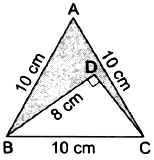
Given: AB = BC = AC = a (let) = 10 cm
BD = 8 cm
Now,
Area of an equilateral triangle (∆ABC) =
=
= 25√3 cm2
= 43.3 cm2
Now, in ∆DBC
Base2 + Perpendicular2 = Hypotenuse2
⇒ DC2 + DB2 = BC2
⇒ DC2 = BC2-BD2
⇒ DC2 = 102-82
⇒ DC2 = 100-64
⇒ DC2 = 36 cm2
⇒ DC = 6 cm
Now,
Area of a triangle (∆DBC) = 1/2 × Base × Height
= 1/2 × DC × BC
= 1/2 × 6 cm × 8 cm
= 1/2 × 48 cm2
= 24 cm2
Now,
Area of shaded region = ∆ABC - ∆DBC
= 43.3 cm2 – 24 cm2
= 19.3 cm2
Exercise: 17b
Q.1. The perimeter of a rectangular plot of land is 80 m and its breadth is 16 m. Find the length and area of the plot.
Given: Perimeter = 80 m
Breadth = 16 m
We know that,
Perimeter of a rectangle = 2(length + breadth)
⇒ 80 m = 2(length + 16 m)
⇒ 40m = length + 16 m
⇒ Length = 40 m – 16 m
⇒ Length = 24 m
Now,
Area of rectangle = Length × Breadth
= 24 m × 16 m
= 384 m2
Q.2. The length of a rectangular park is twice its breadth and its perimeter is 840 m. Find the area of the Park.
Given: Length of park (l) = 2 × breadth(b) = 2b
Perimeter of park = 840 m
We know that,
Perimeter of a rectangle = 2(length + breadth)
⇒ 840 m = 2(2b + b)
⇒ 420 m = 3b
⇒ b = 420/3 m
⇒ b = 140m
Now,
l = 2b = 2 × 140 m = 280 m
Hence,
Area of rectangle = Length × Breadth
= 140 m × 280 m
= 39200 m2
Q.3. One side of a rectangle is 12 cm long and its diagonal measures 37 cm. Find the other side and the area of the rectangle.
Given: Breadth (b) = 12 cm
Diagonal = 37 cm
Let length be l cm
We know that,
Base2 + Perpendicular2 = Hypotenuse2
⇒ l2 + 122 = 372
⇒ l2 = 372-122
⇒ l2 = 1369 cm2 – 144 cm2
⇒ l2 = 1225 cm2
⇒ l = 35 cm
Now,
Area of rectangle = Length × Breadth
= 35 cm × 12 cm
= 420 cm2
Q.4. The area of a rectangular plot is 462 m2 and its length is 28 m. Find its perimeter.
Given: Area = 462 m2
Length = 28 m
We know that,
Area of rectangle = Length × Breadth
⇒ 462 m2 = 28 m × Breadth
⇒ Breadth = 16.5 m
Now,
Perimeter of a rectangle = 2(length + breadth)
= 2(28 m + 16.5 m)
= 2 × 44.5 m
= 89 m
Q.5. A lawn is in the form of a rectangle whose sides are in the ratio 5 : 3. The area of the lawn is 3375 m2. Find the cost of fencing the lawn at RS. 65 per metre.
Given: Cost of fencing lawn = Rs 65 per metre.
Area of lawn = 3375 m2
Length: Breadth = 5: 3
Let,
Length = 5x
Breadth = 3x
We know that,
Area of lawn = Length × Breadth
⇒ 3375 m2 = 5x × 3x
⇒ 3375 m2 = 15x2
⇒ x2 = 225 m2
⇒ x = 15 m
Therefore,
Length = 5x = 5 × 15 = 75 m
Breadth = 3x = 3 × 15 = 45 m
Now,
Perimeter of lawn = 2(length + breadth)
= 2(75 m + 45 m)
= 2 × 120 m
= 240 m
Hence, Cost of Fencing = 240 m × Rs 65 per meter = Rs 15600.
Q.6. A room is 16 m long and 13.5 m board. Find the cost of covering its floor with 75-m-wide carpet at RS. 60 per metre.
Given: Cost of covering = Rs 60 per metre.
Breadth of carpet = 75 cm = 0.75 m
Length of room = 16 m
Breadth of room = 13.5 m
We know that,
Area of room = Length × Breadth
= 16 m × 13.5 m
= 216 m2
Now,
= 288 m
Now,
Cost of covering the floor = 288 m × Rs 60 per meter = Rs 17280.
Q.7. The floor of a rectangular hall is 24 m long and 18 m wide. How many carpets, each of length 2.5 m and breath 80 cm, will be required to cover the floor of the hall?
Given: Length of carpet = 2.5 m
Breadth of carpet = 80 cm = 0.8 m
Length of hall = 24 m
Breadth of hall = 18 m
We know that,
Area of hall = Length × Breadth
= 24 m × 18 m
= 432 m2
And,
Area of carpet = Length × Breadth
= 2.5 m × 0.8 m
= 2 m2
Now,
= 216 carpets
Q.8. A 36-m-long, 15-m-broad verandah is to be paved with stones, each measuring 6 dm by 5 dm. How many stones will be required?
Given: Length of verandah = 36 m
Breadth of verandah = 15 m
Length of stones = 6 dm = 0.6 m
Breadth of stones = 5 dm = 0.5 m
We know that,
Area of verandah = Length × Breadth
= 36 m × 15 m
= 540 m2
And,
Area of stones = Length × Breadth
= 0.6 m × 0.5 m
= 0.3 m2
Now,
= 1800 stones
Q.9. The area of a rectangle is 192 cm2 and its perimeter is 56 cm. Find the dimensions of the rectangle.
Given: Area of rectangle = 192 cm2
Perimeter of rectangle = 56 cm
Let,
Length be l cm
And, breadth be b cm
Now,
Area of rectangle = Length × Breadth
⇒ 192 cm2 = l cm × b cm
Perimeter of rectangle = 2(length + breadth)
⇒ 56 cm = 2(l cm + b cm)
Now, substituting the value of l in this we get,
⇒ 28b = 192 + b2
⇒ b2- 28b + 192 = 0
⇒ b2- 16 b – 12 b + 192 = 0
⇒ b(b - 16 ) – 12(b - 16 ) = 0
⇒ (b - 12 ) (b - 16 ) = 0
This gives us two equations,
i. b – 12 = 0
⇒ b = 12
ii. b – 16 = 0
⇒ b = 16
Let b = 12 cm
Hence,
Length = 16 cm
Breadth = 12 cm
Q.10. A rectangular park 35 m long and 18 m wide is to be covered with grass, leaving 2.5 m uncovered all around it. Find the area to be laid with grass.
Given:
Length of park = 35 m
Breadth of park = 18 m
Now,
Length to be covered = 35 – (2.5 + 2.5)
= 30 m
Breadth to be covered = 18 – (2.5 + 2.5)
= 13 m
Area of park = Length × Breadth
= 30 m × 13 m
= 390 m2
Q.11. A rectangular plot measures 125 m by 78 m. It has a gravel path 3 m wide all around on the outside. Find the area of the path and the cost of gravelling it at RS. 75 per m2.
Length of plot = 125 m and Breadth of plot = 78 m. It has a gravel path 3 m wide all around on the outside.
The area of the path and the cost of gravelling it at RS. 75 per m2.
Since gravel path is 3 m wide all around,
∴ Length of plot with path = 125 + (3 + 3)= 131 m
Breadth of plot with path = 78 + (3 + 3)= 84 m
Now,
Area of the rectangular plot without path= L × B
⇒ Area of the rectangular plot without path = 125 × 78 = 9750 m2
Area of rectangular plot with path = L × B
⇒ Area of the rectangular plot with path = 131 × 84 = 11004 m2
Area of the path = Area of the rectangular plot with path - Area of the rectangular plot without path
= 11004 - 9750= 1254 m2
Cost of gravelling 1 m2 path = Rs 75
Cost of gravelling 1254 m2 path = Rs 75 × 1254 = Rs 94050
Q.12. A footpath of uniform width runs all around the inside of a rectangular field 54 m long and 35 m wide. If the area of the path is 420 m2, find the width of the path.
Given:
Length of field = 54 m
Breadth of field = 35 m
Let width of the path be x m
Area of field = Length × Breadth
= 54 m × 35 m
= 1890 m2
Therefore,
Length of field without path = 54 - (x + x)
= 54 - 2x
Breadth of field without path = 35 - (x + x)
= 35 - 2x
Therefore,
Area of field without path = Length without path × Breadth without path
= (54 - 2x) × (35 - 2x)
= 1890 – 70x – 108x + 4x2
= 1890 – 178x + 4x2
Now,
Area of path = Area of field - Area of field without path
⇒ 420 = 1890 – (1890 – 178x + 4x2)
⇒ 420 = 1890 – 1890 + 178x - 4x2
⇒ 420 = 178x - 4x2
⇒ 4x2 - 178x + 420 = 0
⇒ 2x2 - 89x + 210 = 0
⇒ 2x2 - 84x – 5x + 210 = 0
⇒ 2x(x - 42) – 5(x – 42) = 0
⇒ (x - 42)(2x – 5) = 0
This gives us two equations,
i. x - 42 = 0
⇒ x = 42
ii. 2x – 5 = 0
Since, width of park cannot be more than breadth of field
Therefore, width of park = 42 m.
Q.13. The length and the breadth of a rectangular garden are in the ratio 9 :5. A path 3.5 m wide, running all around inside it has an area of 1911 m2. Find the dimensions of the garden.
Given:
Length : Breadth 9 : 5
Width of the path = 3.5 m
Area of path = 1911 m2
Let,
Length of field = 9x
Breadth of field = 5x
Area of field = Length × Breadth
= 9x × 5x
= 45 x2
Therefore,
Length of field without path = 9x - (3.5 + 3.5)
= 9x - 7
Breadth of field without path = 5x - (3.5 + 3.5)
= 5x - 7
Therefore,
Area of field without path = Length without path × Breadth without path
= (9x - 7) × (5x - 7)
= 45x2 – 35x – 63x + 49
= 45x2 – 98x + 49
Now,
Area of path = Area of field - Area of field without path
⇒ 1911 = 45 x2 – (45x2 – 98x + 49)
⇒ 1911 = 45 x2 – 45x2 + 98x - 49
⇒ 1911 = 98x - 49
⇒ 98x = 1911 + 49
⇒ 98x = 1960
⇒ x = 20
Hence,
Length of field = 9x = 9 × 20 = 180 m
Breadth of field = 5x = 5 × 20 = 100 m
Q.14. A room 4.9 m long and 3.5 m broad is covered with carpet, leaving an uncovered margin of 25 cm all around the room. If the breadth of the carpet is 80 cm, finds its cost at RS. 80 per metre.
Given:
Length = 4.9 m
Breadth = 3.5 m
Margin = 25 cm = 0.25 m
Breadth of carpet = 80 cm = 0.8 m
Cost = Rs 80 per meter
Now,
Length to be carpeted = 4.9 m - (0.25 + 0.25) m
= 4.4 m
Breadth to be carpeted = 3.5 m - (0.25 + 0.25) m
= 3 m
Therefore,
Area to be carpeted = Length to be carpeted × Breadth to be carpeted
= 4.4 m × 3 m
= 13.2 m2
Area of carpet = Area to be carpeted = 13.2 m2
Now,
= 16.5 m
Now,
Cost of 1 m carpet = Rs 80
Therefore, Cost of 16.5 m carpet = Rs 80 × 16.5 m
= Rs 1,320
Q.15. A carpet is laid on the floor of a room 8 m by 5 m. There is a border of constant width all around the carpet. If the area of the boarder is 12 m2 find its width.
Given:
Length = 8 m
Breadth = 5 m
Border = 12 m2
Let the width be x m
Area of floor = Length × Breadth
= 8 m × 5 m
= 40 m2
Now,
Length without border = 8 m - (x + x) m
= (8 – 2x) m
Breadth without border = 5 m - (x + x) m
= (5 – 2x) m
Therefore,
Area without border = Length without border × Breadth without border
= (8 – 2x) × (5 – 2x)
= 40 – 16x – 10x + 4x2
Area of border = Area of floor - Area without border
⇒ 12 = 40 – (40 – 16x – 10x + 4x2)
⇒ 12 = 40 – 40 + 16x + 10x - 4x2
⇒ 12 = 26x - 4x2
⇒ 4x2 – 26x + 12 = 0
⇒ 4x2 – 24x – 2x + 12 = 0
⇒ 4x(x– 6) – 2(x -6) = 0
⇒ (x– 6) (4x -2) = 0
This gives us two equations,
i. x - 6 = 0
⇒ x = 6
ii. 4x -2 = 0
⇒ x = 1/2
Since,
Border cannot be greater than carpet
Hence, width of border is 1/2m = 50 cm
Q.16. A 80 m by 64 m rectangular lawn has two roads, each 5 m wide, running through its middle, one parallel to its length and the other parallel to its breadth. Find the cost of gravelling the roads at RS. 40 per m2.
A 80 m by 64 m rectangular lawn has two roads, each 5 m wide, running through its middle, one parallel to its length and the other parallel to its breadth.
The cost of gravelling the roads at RS. 40 per m2.
Length = 80 m
Breadth = 64 m
Width of road = 5 m
Area of horizontal road = 5 m × 80 m = 400 m2
Area of vertical road = 5 m × 64 m = 320 m2
Area of common part to both roads = 5 m × 5 m = 25 m2
Now,
Area of roads to be gravelled = Area of horizontal road + Area of vertical road - Area of common part to both roads
= 400 m2 + 320 m2 - 25 m2
= 695 m2
Cost of gravelling = 695 m2 × Rs 40 per m2
= Rs 27800
Q.17. The dimensions of a room are 14 m x 10 m x 6.5 m. There are two doors and 4 windows in the room. Each door measures 2.5 m x 1.2 m and each window measures 1.5 m x 1m. Find the cost of painting the four walls of the room at RS. 35 per m2.
Given:
Length of walls = 14 m
Breadth of walls = 10 m
Height of walls = 6.5 m
Length of windows = 1.5 m
Breadth of windows = 1 m
Length of doors = 2.5 m
Breadth of doors = 1.2 m
Cost = Rs 35 per m2
Now,
Area of four walls = 2(Length of walls × Height of walls) + 2(Breadth of walls × Height of walls)
= 2(14 × 6.5) + 2(10 × 6.5)
= 182 m2 + 130 m2
= 312 m2
Area of two doors = 2(Length of doors × Breadth of doors)
= 2(2.5 × 1.2)
= 6 m2
Area of four windows = 4(Length of windows × Breadth of windows)
= 4(1.5 × 1)
= 6 m2
Therefore,
Area to be painted = Area of 4 walls–(Area of 2 doors + Area of 4 windows)
= 312 m2 – (6 m2 + 6 m2)
= 300 m2
Cost of painting = 300 m2 × Rs 35 per m2
= Rs 10500
Q.18. The cost of painting the four walls of a room 12 m long at RS. 30 per m2 is RS. 7560 and the cost of covering the floor with mat at RS. 25 per m2 is RS. 2700. Find the dimensions of the room.
Given:
Length = 12 m
Cost per meter = Rs 30
Total cost = Rs 7560
Cost per meter for floor = Rs 25
Total cost for floor = Rs 2700
Let height be h
Now,
= 2700/25
= 108 m2
= 108/12
= 9 m
= 7560/30
= 252 m2
Area of 4 walls = 2(Length of walls × Height of walls) + 2(Breadth of walls × Height of walls)
⇒ 252 = 2(12 × h) + 2(9 × h)
⇒ 252 = 24h + 18h
⇒ 252 = 42h
⇒ h = 6 m
Therefore,
Dimensions = 12 m × 9 m × 6 m
Q.19. Find the area and perimeter of a square plot of land whose diagonal is 24 m long. [ Take: √2 = 1.41.]
Given:
Diagonal = 24 m
Let the side of square be s
Area of square = 1/2 × Diagonal2
= 1/2 × 242
= 288 m2
Area of square = side2
⇒ 288 m2 = s2
⇒ s = 12√2 m
⇒ s = 16.92 m
Therefore,
Perimeter of square = 4 × 16.92
= 67.68 m
Q.20. Find the length of the diagonal of a square whose area is 128 cm2. Also find the perimeter.
Given:
Area = 128 cm2
Let the side of square be s
Area of square = 1/2 × Diagonal2
⇒ 128 = 1/2 × Diagonal2
⇒ Diagonal2 = 2 × 128
⇒ Diagonal2 = 256
⇒ Diagonal= 16 cm
Area of square = side2
⇒ 128 m2 = s2
⇒ s = 8√2 cm
⇒ s = 11.28 cm
Therefore,
Perimeter of square = 4 × 11.28
= 45.12 cm
Q.21. The area of a square field is 8 hectares. How long would a man take to cross it diagonally by walking at the rate of 4 km per hour?
Given:
Area = 8 hectares = 0.08 km2
Speed = 4 km per hr
Let the side of square be s
Area of square = 1/2 × Diagonal2
⇒ 0.08 = 1/2 × Diagonal2
⇒ Diagonal2 = 2 × 0.08
⇒ Diagonal2 = 0.16
⇒ Diagonal= 0.04 km
= 0.01 hr
= (0.01 × 60) mins
= 6 mins
Therefore,
Time taken = 6 mins
Q.22. The cost of harvesting a square field at RS. 900 per hectare is RS. 8100. Find the cost of putting a fence around it at RS. 18 per metre.
Given:
Rate = Rs 900 per hectare
Total Cost = Rs 8100
Rate of fencing = Rs 18 per metre
Let the side of square field be s
Now,
= 8100/900
= 9 hectares = 90000 m2
Area = side2
⇒ 90000 m2 = side2
⇒ side = 300 m2
Now,
Perimeter = 4 × side
= 4 × 300 m2
= 1200m2
Therefore,
Cost of fencing = 1200 m2 × Rs 18 per metre
= Rs 21600
Q.23. The cost of fencing a square lawn at RS. 14 per metre is RS. 28000. Find the cost of mowing the lawn at RS. 54 per 100 m2.
Given:
Rate = RS. 14 per metre
Total Cost = RS. 28000
Rate of mowing = RS. 54 per 100 m2
Let the side of square field be s
Now,
= 28000/14
= 2000 m
Perimeter = 4 × side
⇒ 2000 m = 4 × s
⇒ s = 500 m
Now,
Area = side2
= (500 m) 2
= 250000 m2
Therefore,
Cost of mowing 100 m2 = Rs 54
= Rs 135000
Q.24. In the given figure, ABCD is a quadrilateral in which diagonal BD = 24 cm, AL ⊥ BD and CM ⊥BD such that AL = 9 cm and CM = 12 cm. Calculate the area of the quadrilateral.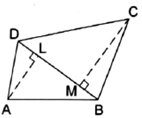
Given:
BD = 24 cm
AL = 9 cm
CM = 12 cm
In ∆ADB,
Area of ∆ADB = 1/2 × BD × AL
= 1/2 × 24 cm × 9 cm
= 108 cm2
In ∆CDB,
Area of ∆CDB = 1/2 × BD × CM
= 1/2 × 24 cm × 12 cm
= 144 cm2
Now,
Area of quadrilateral ABCD = Area of ∆ADB + Area of ∆ADB
= 108 cm2 + 144 cm2
= 252 cm2
Q.25. Find the area of the quadrilateral ABCD in which AD = 24 cm, ∠BAD = 90° and ΔBCD is an equilateral triangle having each side equal to 26 cm. Also find the perimeter of the quadrilateral. [Give: √3 = 1.73.]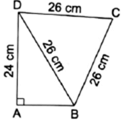
Given:
BC = 26 cm
DC = 26 cm
AD = 24 cm
BD = 26 cm
In ∆BCD,
= 292.37 cm2
In ∆ADB,
Base2 + Perpendicular2 = Hypotenuse2
⇒ AB2 + AD2 = DB2
⇒ AB2 = DB2 - AD2
⇒ AB2 = 262 - 242
⇒ AB2 = 676 - 576
⇒ AB2 = 100
⇒ AB= 10 cm
Area of ∆ADB = 1/2 × AB × AD
= 1/2 × 10 cm × 24 cm
= 120 cm2
Now,
Area of quadrilateral ABCD = Area of ∆ADB + Area of ∆BCD
= 120cm2 + 292.37 cm2
= 412.37 cm2
And,
Perimeter of quadrilateral ABCD = AB + BC + CD + DA
= 10 cm + 26 cm + 26 cm + 24 cm
= 86 cm
Q.26. Find the perimeter and area of the quadrilateral ABCD in which AB = 17 cm, AD = 9 cm, CD = 12 cm, ∠ACB = 90° and AC = 15 cm.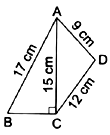
Given:
AC = 15 cm
AB = 17 cm
AD = 9 cm
CD = 12 cm
In ∆ACB (right-angled),
Base2 + Perpendicular2 = Hypotenuse2
⇒ BC2 + AC2 = AB2
⇒ BC2 = AB2 - AC2
⇒ BC2 = 172 - 152
⇒ BC2 = 289 - 225
⇒ BC2 = 64
⇒ BC= 8 cm
Area of ∆ACB = 1/2 × BC × AC
= 1/2 × 8 cm × 15 cm
= 60 cm2
In ∆ADC,
Area of ∆ADC = 1/2 × AD × CD
= 1/2 × 9 cm × 12 cm
= 54 cm2
Now,
Area of quadrilateral ABCD = Area of ∆ACB + Area of ∆ADC
= 60 cm2 + 54 cm2
= 114 cm2
And,
Perimeter of quadrilateral ABCD = AB + BC + CD + DA
= 17 cm + 8 cm + 12 cm + 9 cm
= 46 cm
Q.27. Find the area of the quadrilateral ABCD in which AB = 42 cm, BC = 21 cm, DA = 34 cm and diagonal BD = 20 cm.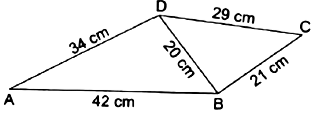
Given:
DB = 20 cm
AB = 42 cm
AD = 34 cm
CD = 29 cm
CB = 21 cm
In ∆ABD(scalene),
Area of a scalene triangle = √(s(s-AB)(s-BD)(s-AD))
Where,
⇒ s = 48 cm
Now,
Area of a scalene triangle = √(48cm × (48-42)cm × (48-20)cm × (48-34)cm)
= √(48 cm × 6 cm × 28 cm × 14 cm)
= √112896 cm2
= 336 cm2
Similarly,
In ∆BCD (scalene),
Area of a scalene triangle = √(s(s-BC)(s-CD)(s-BD))
Where,
⇒ s = 35 cm
Now,
Area of a scalene triangle = √(35 cm × (35-29)cm × (35-20)cm × (35-21)cm)
= √(35 cm × 6 cm × 15 cm × 14 cm)
= √44100 cm2
= 210 cm2
Now,
Area of quadrilateral ABCD = Area of ∆ABD + Area of ∆BCD
= 336 cm2 + 210 cm2
= 546 cm2
Q.28. Find the area of a parallelogram with base equal to 25 cm and the corresponding height measuring 16.8 cm.
Given:
Base = 25 cm
Height = 16.8 cm
Now,
Area of parallelogram = Base × Height
= 25 cm × 16.8 cm
= 420 cm2
Q.29. The adjacent sides of a parallelogram are 32 cm and 24 cm. If the distance between the longer sides is 17.4 cm, find the distance between the shorter sides.
Given:
Longer side = 32 cm
Shorter side = 24 cm
Distance between Longer sides = 17.4 cm
Now,
Area of parallelogram = Longer side × Distance between Longer sides
= 32 cm × 17.4 cm
= 556.8 cm2
Also,
Area of parallelogram = Shorter side × Distance between Shorter sides
⇒ 556.8 cm2 = 24 cm x cm
⇒ x = 23.2 cm
Hence, Distance between Shorter sides = 23.2 cm
Q.30. The area of a parallelogram is 392 m2. If its altitude is twice the corresponding base, determine the base and the altitude.
Given:
Area = 392 m2
Base = b (let)
Height = 2b
Now,
Area of parallelogram = Base × Height
⇒ 392 = b × 2b
⇒ 392 = 2b2
⇒ b2 = 196
⇒ b = 14 cm
Hence,
Base = 14 cm
Altitude = 2 × 14 = 28 cm
Q.31. The adjacent sides of a parallelogram ABCD measure 34 cm and 20 cm, and the diagonal AC measures 42 cm. Find the area of the parallelogram.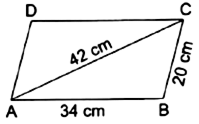
Given:
AB = 34 cm
BC = 20 cm
AC = 42 cm
In ∆ABC (scalene),
Area of ∆ABC = √(s(s-AB)(s-BC)(s-AC))
Where,
⇒ s = 48 cm
Now,
Area of a scalene triangle = √(48cm × (48-42)cm × (48-20)cm × (48-34)cm)
= √(48 cm × 6 cm × 28 cm × 14 cm)
= √112896 cm2
= 336 cm2
Now,
Area of parallelogram ABCD = 2 × Area of ∆ABC
= 2 × 336 cm2
= 672 cm2
Q.32. Find the area of the rhombus, the lengths of whose diagonals are 30 cm and 16 cm. Also, find the perimeter of the rhombus.
Given:
Length of diagonal 1 (d1) = 30 cm
Length of diagonal 2 (d2) = 16 cm
Area of rhombus = 1/2 × d1 × d2
= 1/2 × 30 cm × 16 cm
= 240 cm2
Now,
Side of rhombus = 1/2 × √( d12 + d22)
= 1/2 × √( 302 + 162)
= 1/2 × √(900 + 256)
= 1/2 × √1156
= 1/2 × 34
= 17 cm
Therefore,
Perimeter of rhombus = 4 × Side of rhombus
= 4 × 17 cm
= 68 cm
Q.33. The perimeter of a rhombus is 60 cm. If one of its diagonals is 18 cm long, find (i) the length of the other diagonal, and (ii) the area of the rhombus.
Given:
Perimeter of rhombus = 60 cm
Length of diagonal 1 (d1) = 18 cm
Let, Length of diagonal 2 be d2
(i) Perimeter of rhombus = 4 × side
⇒ 60 = 4 × side
Now,
Side of rhombus = 1/2 × √(d12 + d22)
⇒ 15 = 1/2 × √(182 + d22)
⇒ 15 = 1/2 × √(324 + d22)
⇒ 15 × 2 = √(324 + d22)
⇒ 30 = √(324 + d22)
Squaring both sides,
⇒ 900 = 324 + d22
⇒ 900-324 = d22
⇒ d22 = 576
⇒ d2 = 24
Therefore,
Length of other diagonal = 24 cm
(ii) Area of rhombus = 1/2 × d1 × d2
= 1/2 × 18 cm × 24 cm
= 216 cm2
Q.34. The area of a rhombus is 480 cm2, and one of its diagonals measures 48 cm. Find (i) the length of the other diagonal, (ii) the length of each of its sides, and (iii) its perimeter.
Given:
Area of rhombus = 480 cm2
Length of diagonal 1 (d1) = 48 cm
Let, Length of diagonal 2 be d2
(i) Area of rhombus = 1/2 × d1 × d2
⇒ 480 = 1/2 × 48 × d2
⇒ d2 = 20 cm
Therefore,
Length of other diagonal = 20 cm
(ii) Side of rhombus = 1/2 × √(482 + 202)
= 1/2 × √(2304 + 400)
= 1/2 × √2704
= 1/2 × 52
= 26 cm
Therefore,
Side of rhombus = 26 cm
(iii) Perimeter of rhombus = 4 × side
= 4 × 26 cm
= 104 cm
Therefore, Perimeter of rhombus = 104 cm
Q.35. The parallel sides of a trapezium are 12 cm and 9 cm and the distance between them is 8 cm. Find the area of the trapezium.
Given:
Side 1 = 12 cm
Side 2 = 9 cm
Distance between sides = 8 cm
Now,
Area of trapezium = 1/2 × Sum of parallel sides × Distance between them
= 1/2 × (12 + 9) × 8
= 1/2 × 21 × 8
= 84 cm2
Q.36. The shape of the cross section of a canal is a trapezium. If the canal is 10 m wide at the top 6 m wide at the bottom and the area of its cross section is 640 m2, find the depth of the canal.
Given:
Top width = 10 m
Bottom width = 6 m
Area of cross section = 640 m2
Let the depth be h
Now,
Area of trapezium = 1/2 × Sum of parallel sides × Distance between them
⇒ 640 = 1/2 × (10 + 6) × h
⇒ 640 × 2 = 16 h
⇒ h = 80 m
Q.37. Find the area of a trapezium whose parallel sides are 11 m and 25 m long and the nonparallel sides are 15 m and 13 m long.
Given:
AB (say) = 11 cm
DC (say) = 25 cm
AD (say) = 15 cm
BC (say) = 13 cm
Draw AE ∥ BC
Now the trapezium is divided into a triangle ADE and a parallelogram AECB.
Since, AECB is a parallelogram
Therefore, AE = BC = 13 cm
And, AB = EC
DE = DC – EC( = AB) = 25 – 11 = 14 cm
Now,
We know that,
Area of a scalene triangle (∆AED) = √(s(s-AE)(s-ED)(s-AD))
Where,
⇒ s = 21 cm
Now,
Area of a scalene triangle = √(21cm × (21-13)cm × (21-14)cm × (21-15)cm)
= √(21cm × 8cm × 7cm × 6cm)
= √7056 cm2
= 84 cm2
Also,
Area of a triangle = 1/2 × base × height
⇒ 84 = 1/2 × 14 × height
⇒ height = 12 cm
Now,
Area of a parallelogram = base × height
= 11 cm × 12 cm
= 132 cm2
Now,
Area of Trapezium ABCD = Area of ∆ADE + Area of a parallelogram ABCE
= 84 cm2 + 132 cm2
= 216 cm2

